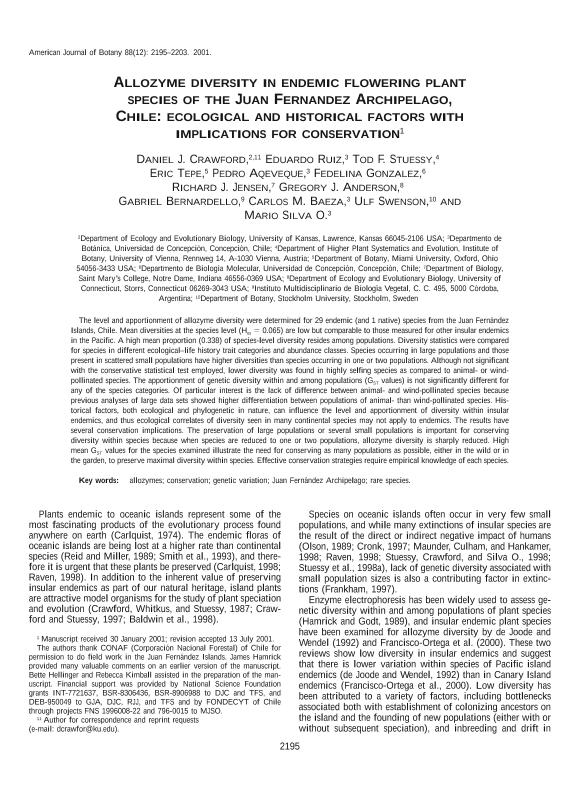Artículo
Allozyme diversity in endemic flowering plant species of the Juan Fernandez Archipelago, Chile: Ecological and historical factors with implications for conservation
Crawford, Daniel J.; Ruiz, Eduardo; Stuessy, Tod F.; Tepe, Eric; Aqeveque, Pedro; Gonzalez, Fedelina; Jensen, Richard J.; Anderson, Gregory J.; Bernardello, Gabriel Luis Mario ; Baeza, Carlos M.; Swenson, Ulf; Silva, Mario O.
; Baeza, Carlos M.; Swenson, Ulf; Silva, Mario O.
 ; Baeza, Carlos M.; Swenson, Ulf; Silva, Mario O.
; Baeza, Carlos M.; Swenson, Ulf; Silva, Mario O.
Fecha de publicación:
12/2001
Editorial:
Botanical Society of America
Revista:
American Journal of Botany
ISSN:
0002-9122
e-ISSN:
1537-2197
Idioma:
Inglés
Tipo de recurso:
Artículo publicado
Clasificación temática:
Resumen
The level and apportionment of allozyme diversity were determined for 29 endemic (and 1 native) species from the Juan Fernández Islands, Chile. Mean diversities at the species level (Hes = 0.065) are low but comparable to those measured for other insular endemics in the Pacific. A high mean proportion (0.338) of species-level diversity resides among populations. Diversity statistics were compared for species in different ecological–life history trait categories and abundance classes. Species occurring in large populations and those present in scattered small populations have higher diversities than species occurring in one or two populations. Although not significant with the conservative statistical test employed, lower diversity was found in highly selfing species as compared to animal- or wind-pollinated species. The apportionment of genetic diversity within and among populations (GST values) is not significantly different for any of the species categories. Of particular interest is the lack of difference between animal- and wind-pollinated species because previous analyses of large data sets showed higher differentiation between populations of animal- than wind-pollinated species. Historical factors, both ecological and phylogenetic in nature, can influence the level and apportionment of diversity within insular endemics, and thus ecological correlates of diversity seen in many continental species may not apply to endemics. The results have several conservation implications. The preservation of large populations or several small populations is important for conserving diversity within species because when species are reduced to one or two populations, allozyme diversity is sharply reduced. High mean GST values for the species examined illustrate the need for conserving as many populations as possible, either in the wild or in the garden, to preserve maximal diversity within species. Effective conservation strategies require empirical knowledge of each species.
Palabras clave:
Juan Fernandez Archipielago
,
Genetic Variation
,
Allozymes
Archivos asociados
Licencia
Identificadores
Colecciones
Articulos(IMBIV)
Articulos de INST.MULTIDISCIPL.DE BIOLOGIA VEGETAL (P)
Articulos de INST.MULTIDISCIPL.DE BIOLOGIA VEGETAL (P)
Citación
Crawford, Daniel J.; Ruiz, Eduardo; Stuessy, Tod F.; Tepe, Eric; Aqeveque, Pedro; et al.; Allozyme diversity in endemic flowering plant species of the Juan Fernandez Archipelago, Chile: Ecological and historical factors with implications for conservation; Botanical Society of America; American Journal of Botany; 88; 12; 12-2001
Compartir
Altmétricas



